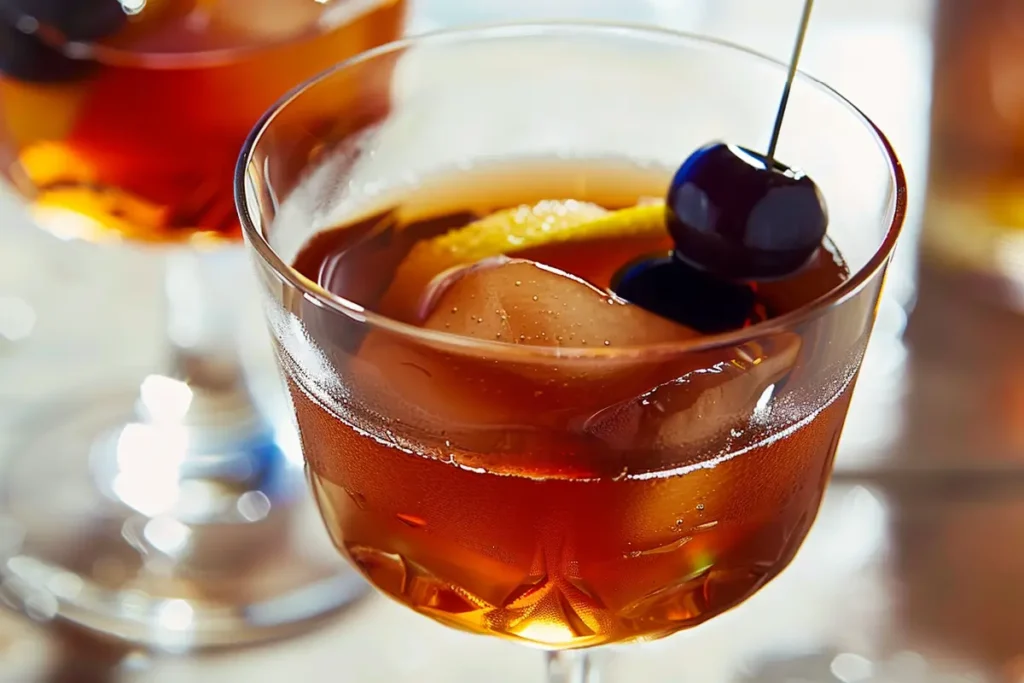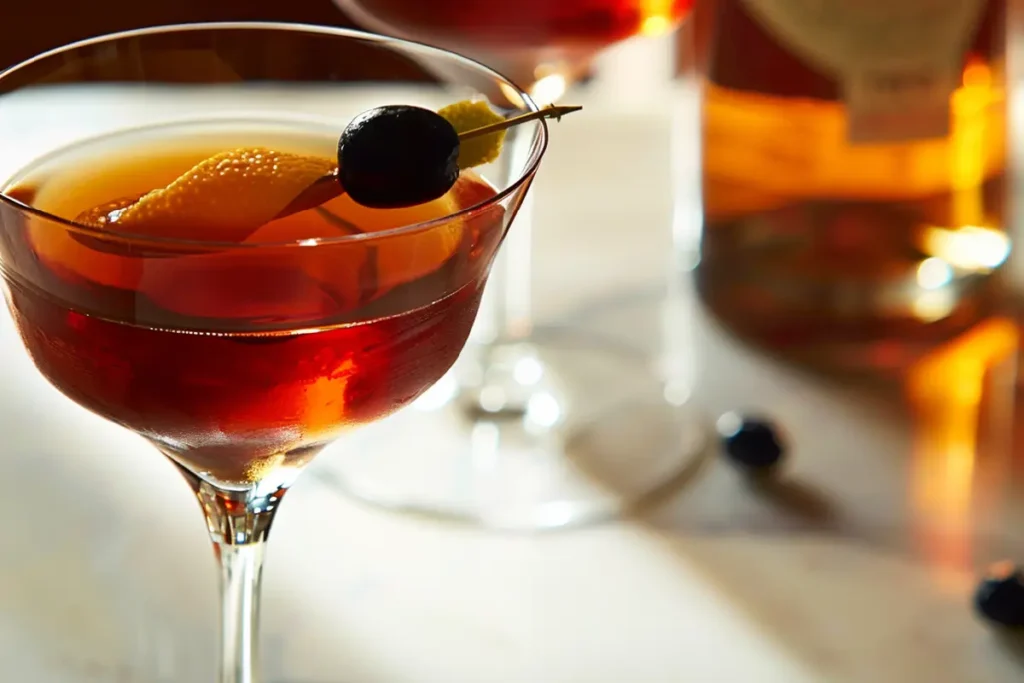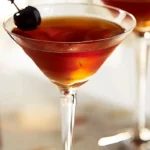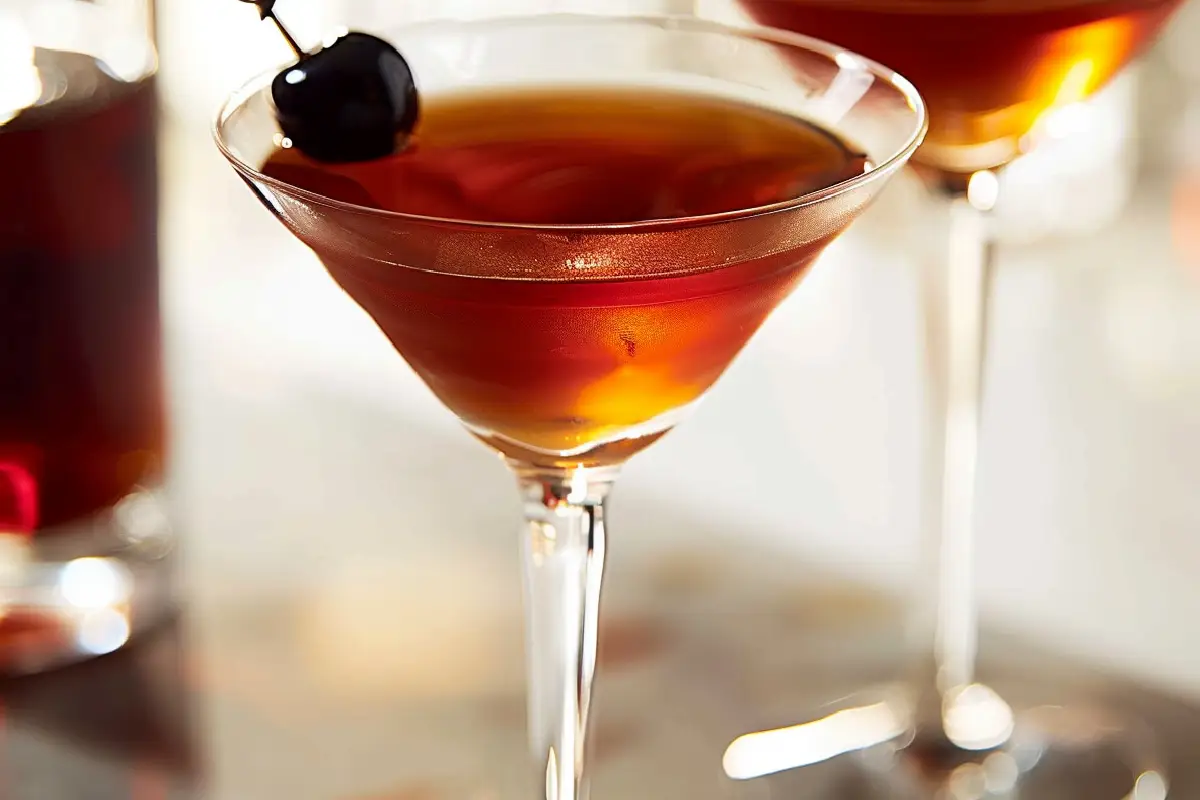Table of Contents: What is a Manhattan Without Vermouth Called?
Introduction: What is a Manhattan Without Vermouth Called?
Picture this: You’re hosting a cozy cocktail hour, ready to impress with a classic Manhattan—only to realize your vermouth bottle is empty. Panic sets in. Can you even make a Manhattan without vermouth? Spoiler: Yes, and it’s a game-changer. This iconic cocktail, known for its bold whiskey backbone and silky-sweet vermouth balance, hides a quirky secret when stripped of its star ingredient.
Did you know the Manhattan cocktail’s origin story involves Winston Churchill’s mom? Legend claims she invented it at New York’s Manhattan Club in the 1870s. But today, we’re flipping the script. Think of this vermouth-free version as the Manhattan’s rebellious cousin: simpler, bolder, and perfect for whiskey purists.
Like our viral 3-Ingredient Old Fashioned, this minimalist twist skips the fuss without sacrificing sophistication. Whether you’re a home mixology newbie or a seasoned bartender, this recipe delivers big flavor in under 5 minutes. Ready to shake up your cocktail routine? Let’s dive in!
What Is a Manhattan Without Vermouth Called?
Let’s address the elephant in the bar: What do you even call a Manhattan without vermouth? A “Kentucky Manhattan”? A “Bare-Knuckle Whiskey Sour”? Nope—it’s cheekily dubbed a “Dry Manhattan” (though purists might side-eye the name). Imagine ordering a martini without gin… it’s just vodka! Similarly, stripping vermouth from a Manhattan leaves you with a whiskey-forward sipper that’s unapologetically bold.
Why the playful rebrand? Blame creative bartenders and resourceful home hosts. As the saying goes, “The way to a great cocktail is through balance”—but sometimes, breaking the rules tastes even better. Try it yourself and decide: Is it a cocktail crime or a stroke of genius?
Why You’ll Love This Recipe

- Whiskey Takes Center Stage
Without vermouth, your bourbon or rye shines brighter than a Broadway marquee. Each sip bursts with caramel, oak, and spice—ideal for fans of stiff, spirit-driven drinks. - Budget-Friendly Brilliance
Skip the $15 vermouth bottle! This minimalist recipe cuts costs without cutting flavor. (Psst: It’s cheaper than bar prices, too!) - Customizable & Quick
Add a dash of bitters for depth, a cherry garnish for sweetness, or a citrus twist for zing. Craving something richer? Try our Bourbon Maple Smash next!
How to Make a Manhattan Without Vermouth
Quick Overview
This 5-minute recipe requires zero fancy tools or techniques. Just whiskey, bitters, and ice. Even better? It’s endlessly adaptable—like the Espresso Martini of whiskey cocktails.
Prep Time: 2 minutes | Total Time: 5 minutes | Serves: 1
Key Ingredients
- 2 oz bourbon or rye whiskey (Jim Beam or Bulleit work great)
- 2 dashes Angostura bitters
- 1 Luxardo cherry or orange twist (optional, for garnish)
- Ice (large cubes preferred)
Pro Tip: Use a bonded whiskey for extra richness!
Step-by-Step Instructions
- Chill Your Glass: Fill a coupe or rocks glass with ice water to cool it.
- Mix: In a mixing glass, combine whiskey and bitters. Add ice and stir 20–30 seconds.
- Strain: Dump ice water from your glass, then strain the cocktail into it.
- Garnish: Add a cherry or citrus twist. Sip slow!
What to Serve With Your Dry Manhattan
- Savory Bites: Sharp cheddar, smoked almonds, or bacon-wrapped dates.
- Sweet Pairings: Dark chocolate truffles or caramelized pecans.
- Cocktail Sidekicks: A cold beer (stout or porter) or a Classic Old Fashioned for guests.
Top Tips for Perfecting Your Cocktail
- Chill Like a Pro: Freeze your glass for 10 minutes pre-mixing.
- No Vermouth? No Problem: Swap in a teaspoon of maple syrup for subtle sweetness.
- Bitter Truth: Overdo the bitters? Balance with a splash of soda water.
Storing and Reheating Tips
Cocktails are best fresh, but you can pre-mix the whiskey and bitters (sans ice) in a sealed jar for 2–3 days. Shake with ice before serving.
FAQs: What Is a Manhattan Without Vermouth Called?

Q: Can I substitute vermouth with something else?
A: Absolutely! Try a splash of sherry, port, or even a teaspoon of maple syrup for sweetness. Purists might balk, but your taste buds won’t.
Q: Is a Manhattan without vermouth just an Old Fashioned?
A: Close, but not quite! An Old Fashioned uses sugar and more bitters, while this riff keeps the Manhattan’s simplicity.
Q: What’s the best whiskey to use?
A: Bourbon adds caramel warmth, while rye brings spicy boldness. Use what you love—even a smoky Scotch works for adventurous sippers.
Q: Can I make this cocktail ahead for a party?
A: Yes! Pre-mix whiskey and bitters in a pitcher (no ice) and refrigerate for up to 2 days. Stir with ice and garnish when ready to serve.
Q: Why does it taste too bitter?
A: Easy fix: Add a teaspoon of simple syrup or a juicy Luxardo cherry to balance the bite.
Conclusion: Redefine Your Happy Hour
Who knew ditching vermouth could lead to such a bold, unapologetically delicious cocktail? Whether you’re a whiskey lover craving purity or a host salvaging a last-minute mixology mishap, this “Dry Manhattan” proves simplicity is king. With just two core ingredients and endless room for creativity, it’s the ultimate quick-fix drink for lazy evenings or impromptu gatherings.
So next time your vermouth runs dry, don’t panic—embrace the shake-up! Whip up this recipe, pair it with salty-sweet snacks, and let the whiskey do the talking.
Your turn: Try this vermouth-free Manhattan tonight and tag us with #NoVermouthNeeded. We’d love to hear your spin! 🥃✨
Print
Black Manhattan
- Total Time: 5 minutes
- Yield: 1 cocktail 1x
- Diet: Gluten Free
Description
A bold, bitter-sweet twist on the classic Manhattan cocktail, the Black Manhattan swaps vermouth for rich amaro (like Averna) for deeper herbal complexity. Perfect for whiskey lovers craving sophistication in under 5 minutes!
Ingredients
- 2 oz rye whiskey (or bourbon)
- 1 oz Averna amaro (or other coffee-forward amaro)
- 2 dashes Angostura bitters
- 1 Luxardo cherry or orange twist (garnish)
- Ice (large cubes preferred)
Instructions
- Chill Glass: Fill a rocks or coupe glass with ice water to chill.
- Mix: In a mixing glass, combine rye, Averna, and bitters. Add ice and stir 25–30 seconds.
- Strain: Discard ice water, strain cocktail into the chilled glass.
- Garnish: Add a Luxardo cherry or orange twist. Serve immediately.
Notes
- Substitutions: Swap Averna for Ramazzotti or Montenegro amaro. Bourbon works if you prefer sweeter notes.
- Pro Tip: Stir longer (35 seconds) for a silkier texture.
- Prep Time: 2 minutes
- Cook Time: 3 minutes
- Category: Cocktails
- Method: Stirred
- Cuisine: American
Nutrition
- Serving Size: 1 cocktail
- Calories: 220
- Sugar: 8g
- Sodium: 1mg
- Fat: 0g
- Saturated Fat: 0g
- Unsaturated Fat: 0g
- Trans Fat: 0g
- Carbohydrates: 10g
- Fiber: 0g
- Protein: 0g
- Cholesterol: 0mg
Keywords: Black Manhattan, amaro cocktail, whiskey drinks, easy cocktails

